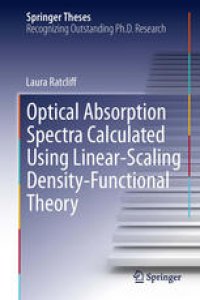
Ebook: Optical Absorption Spectra Calculated Using Linear-Scaling Density-Functional Theory
Author: Laura Ratcliff (auth.)
- Tags: Atomic/Molecular Structure and Spectra, Solid State Physics, Optics Optoelectronics Plasmonics and Optical Devices
- Series: Springer Theses
- Year: 2013
- Publisher: Springer International Publishing
- Edition: 1
- Language: English
- pdf
The development of linear-scaling density functional theory (LS-DFT) has made ab initio calculations on systems containing thousands of atoms possible. These systems range from nanostructures to biomolecules. These methods rely on the use of localized basis sets, which are optimised for the representation of occupied Kohn-Sham states but do not guarantee an accurate representation of the unoccupied states. This is problematic if one wishes to combine the power of LS-DFT with that of theoretical spectroscopy, which provides a direct link between simulation and experiment. In this work a new method is presented for optimizing localized functions to accurately represent the unoccupied states, thus allowing theoretical spectroscopy of large systems. Results are presented for optical absorption spectra calculated using the ONETEP code, but the method is equally applicable to other spectroscopies and LS formulations. Other topics covered include a study of some simple one dimensional basis sets and the presentation of two methods for band structure calculation using localized basis sets, both of which have important implications for the use of localized basis sets within LS-DFT.
The development of linear-scaling density functional theory (LS-DFT) has made ab initio calculations on systems containing thousands of atoms possible. These systems range from nanostructures to biomolecules. These methods rely on the use of localized basis sets, which are optimised for the representation of occupied Kohn-Sham states but do not guarantee an accurate representation of the unoccupied states. This is problematic if one wishes to combine the power of LS-DFT with that of theoretical spectroscopy, which provides a direct link between simulation and experiment. In this work a new method is presented for optimizing localized functions to accurately represent the unoccupied states, thus allowing theoretical spectroscopy of large systems. Results are presented for optical absorption spectra calculated using the ONETEP code, but the method is equally applicable to other spectroscopies and LS formulations. Other topics covered include a study of some simple one dimensional basis sets and the presentation of two methods for band structure calculation using localized basis sets, both of which have important implications for the use of localized basis sets within LS-DFT.
The development of linear-scaling density functional theory (LS-DFT) has made ab initio calculations on systems containing thousands of atoms possible. These systems range from nanostructures to biomolecules. These methods rely on the use of localized basis sets, which are optimised for the representation of occupied Kohn-Sham states but do not guarantee an accurate representation of the unoccupied states. This is problematic if one wishes to combine the power of LS-DFT with that of theoretical spectroscopy, which provides a direct link between simulation and experiment. In this work a new method is presented for optimizing localized functions to accurately represent the unoccupied states, thus allowing theoretical spectroscopy of large systems. Results are presented for optical absorption spectra calculated using the ONETEP code, but the method is equally applicable to other spectroscopies and LS formulations. Other topics covered include a study of some simple one dimensional basis sets and the presentation of two methods for band structure calculation using localized basis sets, both of which have important implications for the use of localized basis sets within LS-DFT.
Content:
Front Matter....Pages i-xi
Introduction....Pages 1-3
Density-Functional Theory....Pages 5-21
Linear-Scaling Methods....Pages 23-44
Theoretical Spectroscopy....Pages 45-58
Basis Sets and Band Structures....Pages 59-79
Conduction States: Methods and Applications....Pages 81-96
Results and Discussion....Pages 97-114
Conclusion....Pages 115-116
The development of linear-scaling density functional theory (LS-DFT) has made ab initio calculations on systems containing thousands of atoms possible. These systems range from nanostructures to biomolecules. These methods rely on the use of localized basis sets, which are optimised for the representation of occupied Kohn-Sham states but do not guarantee an accurate representation of the unoccupied states. This is problematic if one wishes to combine the power of LS-DFT with that of theoretical spectroscopy, which provides a direct link between simulation and experiment. In this work a new method is presented for optimizing localized functions to accurately represent the unoccupied states, thus allowing theoretical spectroscopy of large systems. Results are presented for optical absorption spectra calculated using the ONETEP code, but the method is equally applicable to other spectroscopies and LS formulations. Other topics covered include a study of some simple one dimensional basis sets and the presentation of two methods for band structure calculation using localized basis sets, both of which have important implications for the use of localized basis sets within LS-DFT.
Content:
Front Matter....Pages i-xi
Introduction....Pages 1-3
Density-Functional Theory....Pages 5-21
Linear-Scaling Methods....Pages 23-44
Theoretical Spectroscopy....Pages 45-58
Basis Sets and Band Structures....Pages 59-79
Conduction States: Methods and Applications....Pages 81-96
Results and Discussion....Pages 97-114
Conclusion....Pages 115-116
....